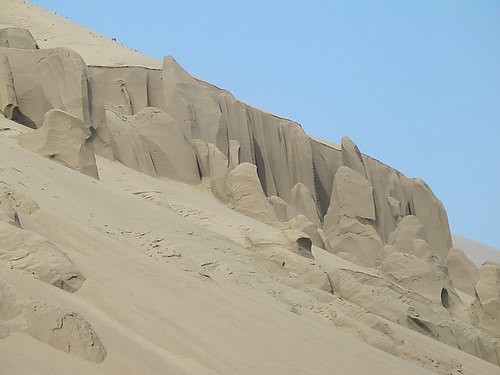I’d been reading about Caral, considered to be the oldest city in the Americas, in the fascinating book 1491, a new look at archaelogical discoveries in the New World by Charles Mann. So when Sarita suggested a day trip, I jumped at the chance.
Sara booked a tour, and after a few mishaps inevitable to group travel, we were on our way. The three-hour drive up the coast took us past dramatic wind-sculpted dunes, rickety hillside favelas and cement block towns. Most drifted off to sleep; the 5:30 a.m. wakeup call had come far too early (and, in the case of Jeff, it didn’t come at all, which is why we were half an hour late).

Sleepy passengers awoke to find our driver sitting silently on the side of the road. Finally he made a wide U-turn and headed back the way we’d come. After a while, he turned right onto a road that looked a bit more developed than a cattle trail and forged his way into the countryside. We held our breaths as he scraped his way across boulders and forded a small lake until he finally ground to a halt, the van impaled on a pile of bricks.
At this point we all got out and let him try to move forward, but the wheels spun helplessly in the sand, digging the van in more deeply with each try. It was clear this driver didn’t know what he was doing. We all set about trying to help, placing bricks under the wheels and pushing.
Finally a barefoot farmer appeared from the nearby shack made from woven palm leaves. He was incredulous at the sight of a van full of tourists.
“You’re looking for Caral? It’s 2 kilometers back that way; you’ll know you’re there, there’s a big sign.”
The passengers piled back into the van and making our precarious way back out to the highway and to the sign indicating we had arrived at the UNESCO-designated World Heritage Site.
The road wasn’t much bigger than the one we’d traversed, and the site was easy to miss. Unlike Macchu Pichu, where hordes of tourists descend every year, Caral is a relatively new destination and, indeed, a new archaelogical find. For years it was overlooked by archaeologists who didn’t place any importance on the series of hills along the Peruvian coast. It wasn’t until Peruvian archaeologist Ruth Shady Solis intuited the presence of something more, began a dig on the site and sent some of her findings to the States for carbon dating, that its true antiquity was revealed, and the world community began to take note.
Even with the mishaps, Caral was definitely worth the trouble. Built at around the same time as the Egyptian pyramids, the 150-acre site is just one of a complex of similar cities in the region that have forced archaeologists to rethink their estimates of the so-called New World. As the dig continues, “we may be forced to stop calling it the New World,” writes Mann, as it may well turn out the first civilizations developed here, and not in Mesopotamia as previously believed.
Our guide was a resident of the nearby town, trained as had been a number of locals in a community development initiative launched by Ruth Shady Solis, the pioneering archaeologist who had discovered this phenomenal site. The site has taken a leading role in lifting the neighboring community out of poverty, as she shared with us during a detailed tour of the ancient city.
One of the most interesting finds was a collection of flutes made from the bones of birds – proof that even from ancient times, Peruvians were musicians – and loved to celebrate!
We ended our tour in the nearby town of Huacho, where we celebrated a delicious lunch with papas huancaina, lomo saltado, passion fruit juice and, of course, Inka cola!
Created with Admarket’s flickrSLiDR.

Leave a Reply